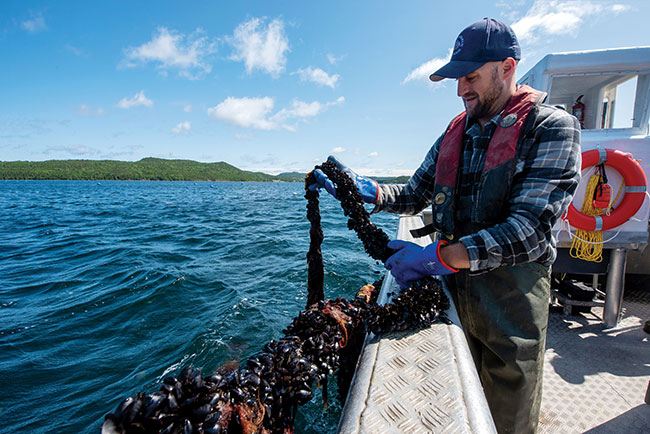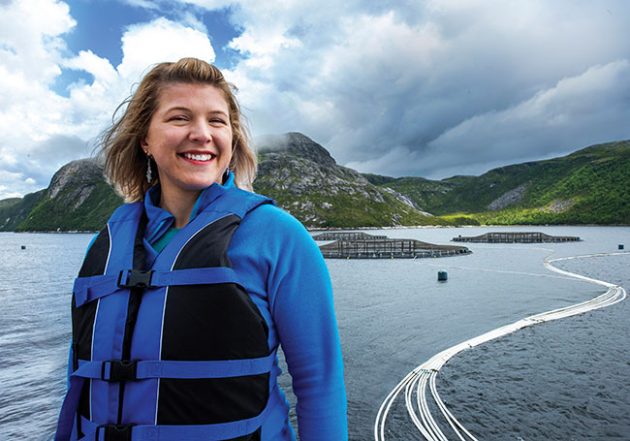
Viewpoint: Newfoundland is not for the faint of heart
August 23, 2022
By Jamie Baker
It takes a special sort of determination to be successful working the cold, clear waters of the Northwest Atlantic.
 PHOTO courtesy of jamie baker
PHOTO courtesy of jamie baker This region is a unique environment that presents many difficult challenges for various industries, and it’s not for the faint of heart. At the same time, it’s also an environment that greatly rewards those who innovate and persevere.
People in the Newfoundland and Labrador aquaculture sector know this fact only too well.
What started out as a near-cottage industry curiosity in the 1990s (although N.L.’s aquaculture lineage can be traced back to the late 1800s when Norwegian Adolf Nielsen farmed cod and lobster in Trinity Bay) has developed today to become one of the important sectors in the province.
With current production focused on Atlantic salmon, steelhead trout, blue mussels and American oysters, as well as strong potential for alternative species including cleanerfish, wolffish, urchins and kelps, the positive impacts of aquaculture in NL carry some truly incredible positive impacts.
For example, first and foremost, sea farming provides critical food security for the people of the province, many of whom live on an island. The sector accomplishes that goal, while creating a minuscule carbon footprint for protein production, and dramatically increasing world-class economic development and employment opportunities in rural, coastal communities.
There is, quite simply, no other sector in NL that combines all those factors, and carries such incredible growth potential; after all, Newfoundland and Labrador represent one of the last truly great, untapped sea farming opportunities in the world. Wherein, we have the right conditions needed to grow world class product, the physical space available to expand, a wealth of ocean and technical expertise and experience, and all of it right next to the huge U.S. market.
It’s a dream scenario for responsible, sustainable growth.
Of course, it will take a tremendous amount of work to achieve, but it all couldn’t come at a better time.
Building momentum
After a challenging couple of years pressing through the pandemic and some other industry issues, 2022 is showing some early, positive momentum for the sector in the province.
On the production side, the numbers from 2021 show a strong rebound for the NL sector coming out of the pandemic: The province’s production volume came in at 19,635 metric tonnes (up 84.9 percent from 2020), and was worth an estimated $189.3 million (an increase of 96.3 percent).
The focus now for the province is sustainable growth of the sector; the province and industry have a shared goal of reaching 50,000 tonnes of salmon production and 10,750 tonnes of mussel production in the years ahead. The signs of progress towards that shared goal are finally becoming apparent.
After several years of planning, hard work and dedication, Grieg Seafood NL officially opened its multimillion-dollar facility in Marystown, N.L. in April 2022 with fish scheduled to go into Placentia Bay in May. Having toured the facility and met the people, many of them young, dynamic people looking to make a life, not just a living, on the Burin Peninsula, it’s hard not to cheer for their success given the epic levels of commitment invested by the people and the company.
Right on the heels of that announcement, the Government of Newfoundland and Labrador announced in May that Grieg was the proponent selected to explore potential expansion of sea farming into the Bays West region from Bay D’Espoir to Burgeo. Those waters carry with them the potential to produce 15,000 to 20,000 tonnes of salmon and hundreds of jobs in an area that surely will welcome it.
Again, there will be a lot of time and effort required to make it all come together, but everyone involved understands what’s required to succeed in Newfoundland and Labrador. The three primary salmon companies in the province – Grieg Seafood Newfoundland, Cooke Aquaculture and Mowi Canada East – all bring incredible international-level industry knowledge, resources and expertise to the equation and are well positioned to help the industry achieve its goals.
On the shellfish side of the industry, things are no less exciting. This province is home to the first certified organic blue mussels in North America, and the province is also working to develop several new brands of oysters. The production volume of shellfish in N.L. in 2021 was 3,731 metric tonnes, up 32.4 percent over 2020. The corresponding sector value also increased 33.4 percent to $16.5 million, and really, that’s only scratching the surface of what those species can produce.
The province is also seeing increased interest in alterative species like cleanerfish (lumpfish and cunners), which are showing some impressive results in sea lice mitigation. Wolffish is another potential commercial species being investigated and there is continued interest in cod, urchin farming and potential kelp development.

PHOTOS: Newfoundland Aquaculture Industry Association
NAIA at the forefront
It is clear the Newfoundland Aquaculture Industry Association (NAIA) will play a vital role in achieving overall industry success in its continuing role as the voice of the industry. Using our online platforms, social media, marketing, direct advocacy, and tools like the newly introduced Aquaculture 101 (an educational resource utilizing virtual reality technology), NAIA is constantly educating the public on the positive impacts of aquaculture.
People in the province are starting to understand how important farmed fish is to their future food security. They are understanding how the sector is constantly advancing and living up to its role as the most environmentally friendly farmed protein on the planet, and they are appreciating all the great opportunities the sector brings to the province and its people.
We also continue to work closely and collaboratively with our municipal, provincial, and federal government colleagues to advocate on behalf of the industry, help the sector advance, and to discuss/support sensible and effective regulation where applicable.
Above all, NAIA effectively brings together all the players in the sector – companies, farmers, scientists, service and supply groups, government and technology firms – to ensure collective responsible development of the sector now and in the future.
At its core, aquaculture is really all about feeding people, and nowhere in the world is there stronger potential than in Newfoundland and Labrador. Indeed, as our recent campaign suggests, N.L. Aquaculture really does bring so much to the table – a table that is growing, and ready to add more chairs.
Jamie Baker is the executive director of the NL Aquaculture Industry Association (NAIA) based in St. John’s, Newfoundland and Labrador. He worked in Ottawa, Ontario leading federal programs focused on sustainable use research, development, and wildlife conservation along with spearheading key market access and growth initiatives nationally and internationally.





